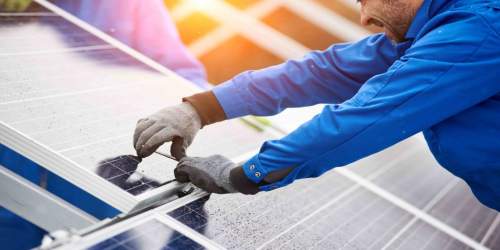Read Time : 8 Minutes
How Much do Solar Panel Systems Cost in 2024?
This is a big question. Getting an honest and straight forward answer for 'how much do solar panels cost and what return on your investment can you expect' is not easy. To get an accurate grasp of the figures you need to gather some data and before signing on the dotted line you'll need to consider many variables. So, before we start plucking numbers from the aether, here are the factors you need to weigh up.
Considerations when installing solar energy
• The type of panels
• The size of the array
• The complexity of your system
• Aesthetics
• How much electricity you use
• How much electricity your system produces
• The suitability of your property
• Potential grants, incentives, and schemes
• Your negotiating skills and research
• Geographical location
• Solar storage
We’ll crunch numbers in a moment but before we do, let’s go through the list and explain why each factor is important.
Panel type: There are two basic variants of solar panels on the market, with a third about to land soon (nothing guaranteed yet though). These are monocrystalline and polycrystalline with Perovskite-silicon in development. Monocrystalline panels are dark, almost black in appearance and they're the current gold standard in efficiency. Polycrystalline are blue in colour and less efficient, but cheaper than their cousins.
Perovskite-silicon panels, on paper, promise a quantum leap in efficiency… and likely price. We hope that Perovskite-silicon panels will hit the market as early as 2025 but we could be waiting for a few years past that.
Size of your system: Check the wattage output of the proposed system. It's likely that the higher the output, the larger the price tag. A PV system should be sized for your needs and your wallet.
The complexity of your system: The market is improving all the time. Right now, there are a number of gizmos and gadgets to help upgrade the efficiency and application of your system… and its price tag.
Aesthetics: Most solar systems come as standard. If want a prettier version with less obvious metalwork, thinner panels, or even solar roof tiles, you can add a few quid to your bill.
The availability of solar tiles in the UK is limited. It's a technology that's really still in development. Only a few UK solar companies offer a solar tile solution, so if you've got a listed property and there's no chance of panels, fill out a Contact Us form and we'll try to help.
How much energy you use: A decent solar system can produce up to 70% or more of the power you need. If you end up paying for a system that exceeds those needs, expect an excessive initial investment and potentially a longer pay-back period.
How much energy your system produces: Bigger systems cost more money… but! The more energy you produce the more you can sell, and this can affect the bottom line. Although the Smart Export Guarantee isn't the money spinner the FiT was, it still helps towards your pay-back period.
The suitability of your property: For the most effect, you want an unobscured, south-facing sloped roof with no shade. Otherwise, expect to add numbers to the initial outlay and potentially your pay-back period.
Potential grants, incentives, and schemes: The glory days are gone, but you may still be able to squeeze a few quid out of someone for your solar array. More info on this below.
Your negotiating skills and research: Good news, as you’re here you’re already one step ahead of the crowd. Now, also remember that the solar market is competitive so don’t be afraid to haggle.
Geographical location: Like they always say, it’s all about location, location, location. In solar terms this is important for three reasons. First, the sunnier it is where you live the better chance you’ll have to generate power. Second, if you live in a pricier part of the country, you may pay more for the initial outlay. Third, some areas are more receptive to renewable energy than others. Scotland, for example, still offers actual grants, while cities like Brighton and Hove with their Green council and MP can help you cut the red tape.
Solar storage and when you install them: We’ll dive into this in a bit. It’s worth mentioning though, that solar storage and when you install it can really affect the initial price and payback period of your system. We’ll talk about this more under VAT later, but how VAT applies to solar batteries is another factor to consider.
COMPARE PRICES FROM LOCAL INSTALLERS
Compare prices from local companies fast & free
Enter your postcode to compare quotes from leading professionals. We promise to keep your information Safe & Secure. Privacy Policy
The cost of solar panels PV in the UK
Now, that’s out of the way let’s look at some numbers. The infographic below will give you a good idea of approximate costs.
Case Study: solar installation for an average UK home
• House type: Semi-detached
• Solar panels: polycrystalline 4kW
• Number of panels: 10-14
• Solar panel cost, including installation: £6000.00
• Estimated annual output: 3600 kWh
• Estimated Smart Export Guarantee Tariff: £80.00
• Estimated savings on fuel bills: £608.00 PA
• Total Savings/Earnings in a year: £688.00 PA
Please note: these figures don't consider the average annual (est. 10%) increase in electricity costs from providers. So, your electricity bills could double over ten years giving you higher savings and cutting the payback period.
Let's look a bit closer with another example and a bit more detail on how the increase in electricity costs can effect the payback period.
• A household installs a 5kW photovoltaic system costing £8000, which would generate approximately 4320 kWh of electricity annually.
• Assuming you use 50% of the electricity and you're paying 28 pp kWh (pence per kilowatt hour) and selling the other 50% to your energy provider for let's say 15 pp kWh. (a leading utility company's current SEG tariff)
• The electricity bill saving would total £604.80 PA (electricity used in your home - 2160 kWh x 28p - this is the electricity that does not need to be bought from a utility company)
• The annual SEG income would be £324 per annum.
• Without considering the annual 3.6% increase in energy costs, this totals £928.80 per year creating a simple pay-back period calculation of 8.61 years.
• If we add-in the average increase in the price of electricity in the UK every year, the total saving or ROI over twenty years would be £28,619.15
It's certainly worth noting that the price of electricity per unit was increasing by 3.6% per year until 2022 when we saw a huge jump. In reality the cost of electricity per unit has basically doubled in 10 years, or 10% per year on average!
All these figures are approximate but give you an idea of how the costs and pay-back periods can be worked out.
Chucking a battery into the mix brings a bunch more variables but the same sort of calculations can be made. More on that further on.
| Property Type | Approx. Roof size | Approx System size | Average System cost | Co2 Saved Per Year (tonnes) | Approximate Yearly System output |
|---|---|---|---|---|---|
| Terraced | 8m² | 1kWp | £ 2500- £3000 | 0.5 | 900 kWh |
| Semi-detached | 15m² | 3kWp | £ 3000- £4000 | 1 | 2,700 kWh |
| Average detached | 28m² |
4kWp |
£ 6000- £8000 | 1.5 - 2 | 3,600 kWh |
Location and other return on investment factors
Don’t forget that your location will also play a part in your return on investment (ROI). If you live in an area with more sunlight hours, (e.g. Devon or the South Coast) or higher traditional fuel costs (e.g. London), then you’ll pay off your system faster.
Incentives and schemes
As you’ll see, these initiatives come and go, but you can expect to see some form of incentive to promote renewable energy like solar.
Feed In Tariff scheme (FIT)
The Feed In Tariff (FIT) closed for applications in 2019, but if you buy a house with a solar array in place it may still apply. FIT was a generous incentive that paid solar users a tiny fee for all the energy they produced and a bigger fee for the energy they sold back to the grid. In 2020 the government's new scheme, the Smart Export Guarantee (SEG) replaced FIT. Although some FIT tariffs exist for folks who signed up before the program closed.
Smart Export Guarantee (SEG)
Like FIT, SEG pays solar owners for energy they sell back to the grid. Unlike its predecessor SEG doesn’t pay anything for total units produced. SEG tariffs vary from energy supplier to energy supplier and come in the form of variable or fixed rates. At a minimum SEG guarantees to pay at least £75 a year in tariffs, but, the number should be far higher. Most households save between £85 to £500 per year through the Smart Export Guarantee. Anyone lucky enough to still have FIT will earn even more.
Free solar panels
Past schemes allowed solar suppliers to offer free solar systems in exchange for their Feed In Tariff revenue. Alas, as FIT is no more most of these deals died with it. You may still be able to find a company prepared to loan you the money to fit solar panels though. Finance for these loans came from the potential savings from your energy bills. The idea is the money you saved on lower bills would cover the interest payments, but be cautious they're still loans.
ECO4 and LAFLEX
One 'free solar incentive' still online is the government's Energy Company Obligation or ECO program. Now in its fourth iteration, hence ECO4, the Energy Company Obligation and its subsequent upgrade LAFLEX (Local Authority Flexibility) nudged energy providers to help improve low energy efficient households. Depending on the criteria, it's still possible to get finance to make improvements like the installation of solar panels through the ECO4 initiative. LAFLEX, despite its exotic sounding acronym, was added later to give local authorities added flexibility in helping more folks qualify.
You can find out more here...
https://www.gov.uk/government/consultations/design-of-the-energy-company-obligation-eco4-2022-2026
Home Energy Scotland Grant and loan
Unlike other parts of the UK, the Scottish government does still provide grant funding. This scheme provides aid for renewable energy and energy efficiency improvements. These grants cover up to 75% of the cost of energy improvements. These improvements include solar installations, double glazing, insulation, and more. The grants offer up to a maximum of £7500 or £9000 depending on criteria. As with all legislation and regulations these funds are prone to change. It's always keeping up to date with them. Indeed, this month June 2023, Home Energy Scotland made a significant announcement. From the 27th of June 2023, only applications including a heat pump or high heat retention storage systems are eligible. Applicants looking for Solar PV systems only won't qualify under the scheme. Like other government projects expect a fair amount of red tape, and fine print. It's also worth remembering that although the grants will only cover 75% of costs. However, the initiative does include provisions for top up loans for eligible applicants.
Cash is king!
If you have the capital, the smart way to get solar is to pay for it outright. Buying your solar PV system upfront means you can recoup the cost from the start. This offers a better ROI than leaving the money in the bank. If you don’t have the cash to hand, however, it’s worth considering a loan. Make sure to calculate any interest payments on finance when working out your pay-back period.
Beware of VAT
It's fair to say that despite the government's best efforts, most of the official incentives are opaque at best. It's worth taking time to understand the current rules, pitfalls, and loopholes. One incentive that's fairly straight forward is the government's list of energy-saving materials that benefit from VAT relief. Up until Feb 2024, you would only get VAT exemption for batteries when installed in combination with solar panels. Now, retrofitted and stand-alone battery installations will benefit from a 0% rate of VAT. A saving of 20%!
Finance options for solar panels
Many companies offer finance for solar technology in the United Kingdom. Finance, loans and leasing agreements are available for domestic, commercial, and industrial installations.
Finance for renewable energy technologies spares you the need to tie up capital in your system. A typical solar system would pay for itself over its lifetime including any interest but make sure you consider interest payments when working out a payback period.
Of course, all finance options involve an element of risk, but some providers offer to offset that risk by owning the solar system from the out. This is rare these days though and usually reserved for commercial installs.
Rates and offers vary and it’s always wise to seek independent financial advice before embarking on such a scheme.
Solar Together and group buying options
One nifty new idea in the renewable energy market is group purchasing. There are now organisations out there like Solar Together. These groups unite like-minded folks looking for solar panels before auctioning the bulk contracts to vetted lists of suppliers. Of course, you don't need any help to pop next door to see if you can't come up with a joint plan, in the same way you might chat about joint roof improvements. Depending on your own initiative, you might want to take the idea a little further like Walthamstow couple Dan Edelstyn and Hilary Powell. The pair slept on the roof of their London home for 23 nights late last year in 2022. In a bid to raise £100,000 to install solar panels for their whole street. Of course, you don't have to go quite the same lengths as Dan, and Hilary whose efforts also included releasing a top 21 song and camping out on their roof. Still, you never know where a quick cup of tea with the neighbours could lead.
https://www.bbc.co.uk/news/uk-england-london-64151663
https://solartogether.co.uk/info/about-us
What kind of system should you install?
Two solar systems dominate the market at present and both work in different ways.
Solar PV systems and Solar thermal systems
Solar PV systems: A solar PV system is what most folks think of when they think about solar power. They work by collecting the sun’s energy through their PV (photovoltaic) cells. This energy is then converted into electricity.
Solar thermal systems: By contrast solar thermal systems use the sun’s energy to heat a special transfer fluid. This liquid then transfers that heat through a heat exchanger to generate hot water.
Solar PV and solar thermal pro's and con's
There are upsides and downsides to both systems. In simple terms though, solar thermal systems work better in warmer climates, although they are generally cheaper to install.
The true costs, savings, and return on investment of installing a solar system come down to you, your location, and your lifestyle choices.
Final thoughts
However, if you decide to proceed, installing a solar system is an excellent investment. Take your time to consider the best path and don’t rush the decision. It’s worth reading our excellent mega guide which we’ll link to in a moment. In that guide, you’ll find a section all about the considerations you need to factor in before getting your bank card out. If you have the perfect situation, i.e. you live on the south coast, have a south-facing roof, and cash in the bank, then you probably already have solar. If not… well, get on with it! For the rest of us, you’ll need to factor in the mitigating conditions we’ve discussed above. Since you’ve come this far, and thanks for taking the time to read our guide by the way, (*cough… a share? Why that would be lovely…) then please look at our solar panel mega guide. This link takes you to our comprehensive up-to-date inclusive solar guide.
We also have these related guides:
How much space do I need for solar panels? (This article has useful information about pay-back periods)
How much electricity does a solar system produce? (This article helps explain what you can expect your system to produce)
Find a local installer
Welcome to the biggest directory of UK renewable energy companies






 How Much do Solar Panel Systems Cost in 2024?
How Much do Solar Panel Systems Cost in 2024?







